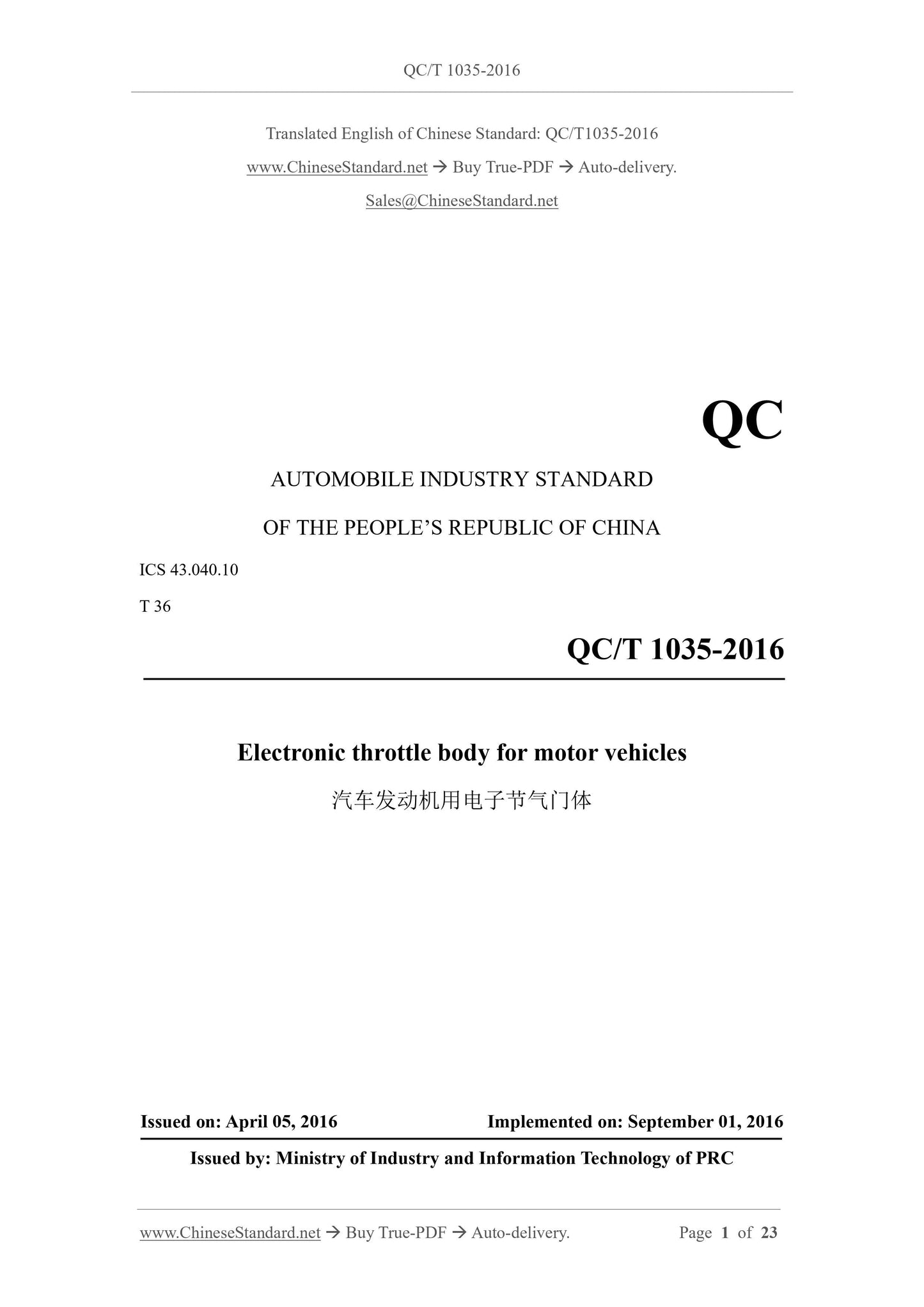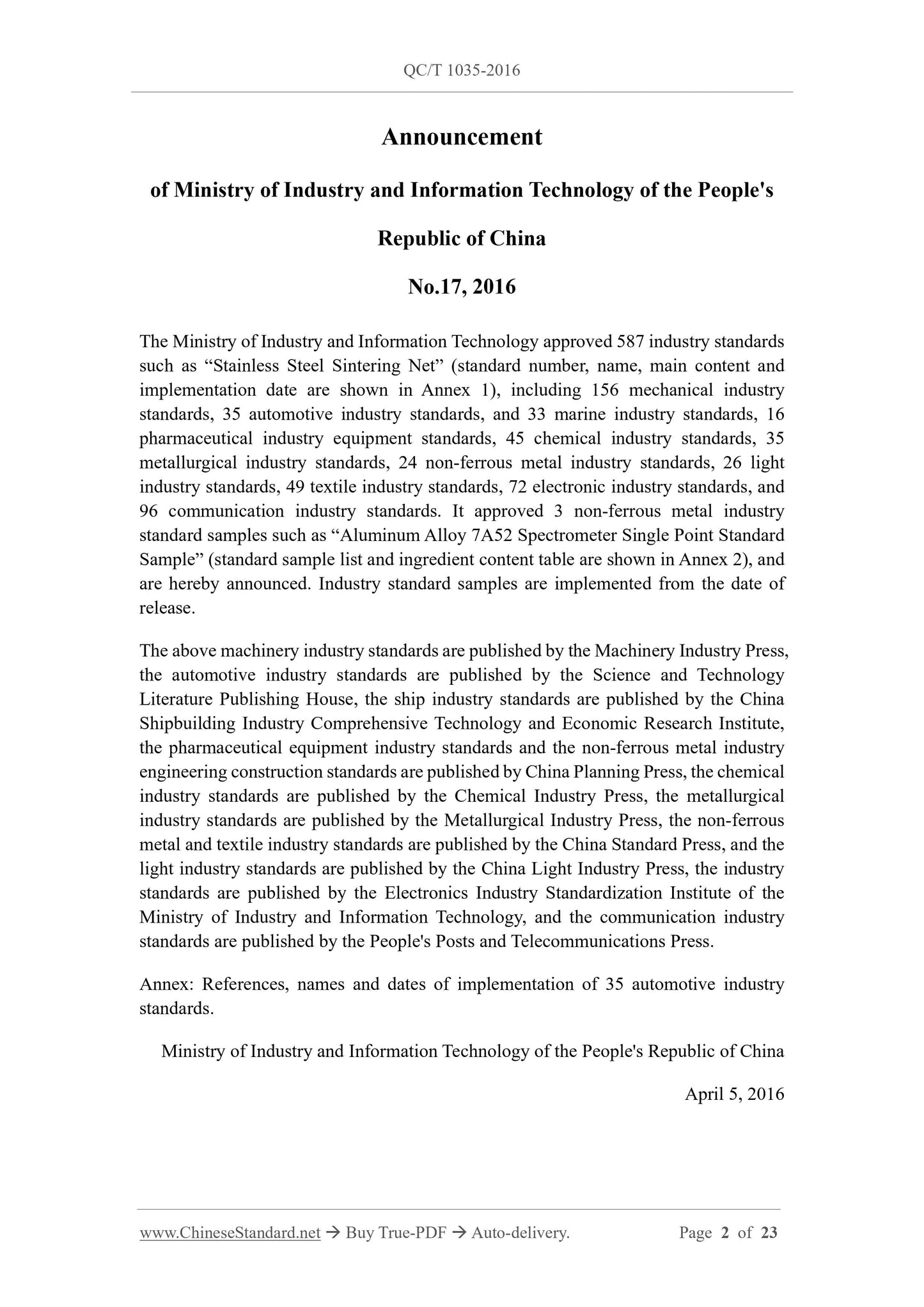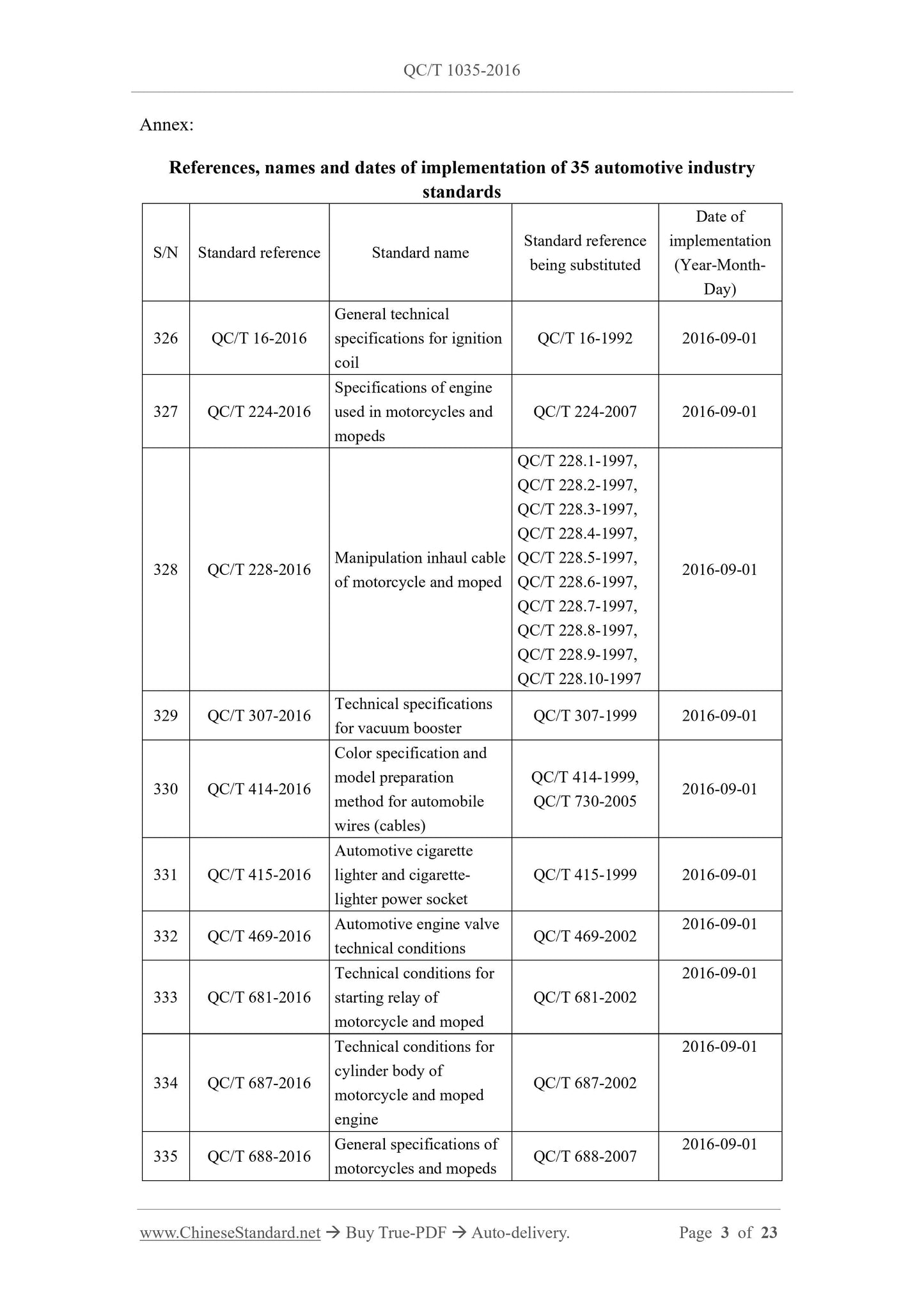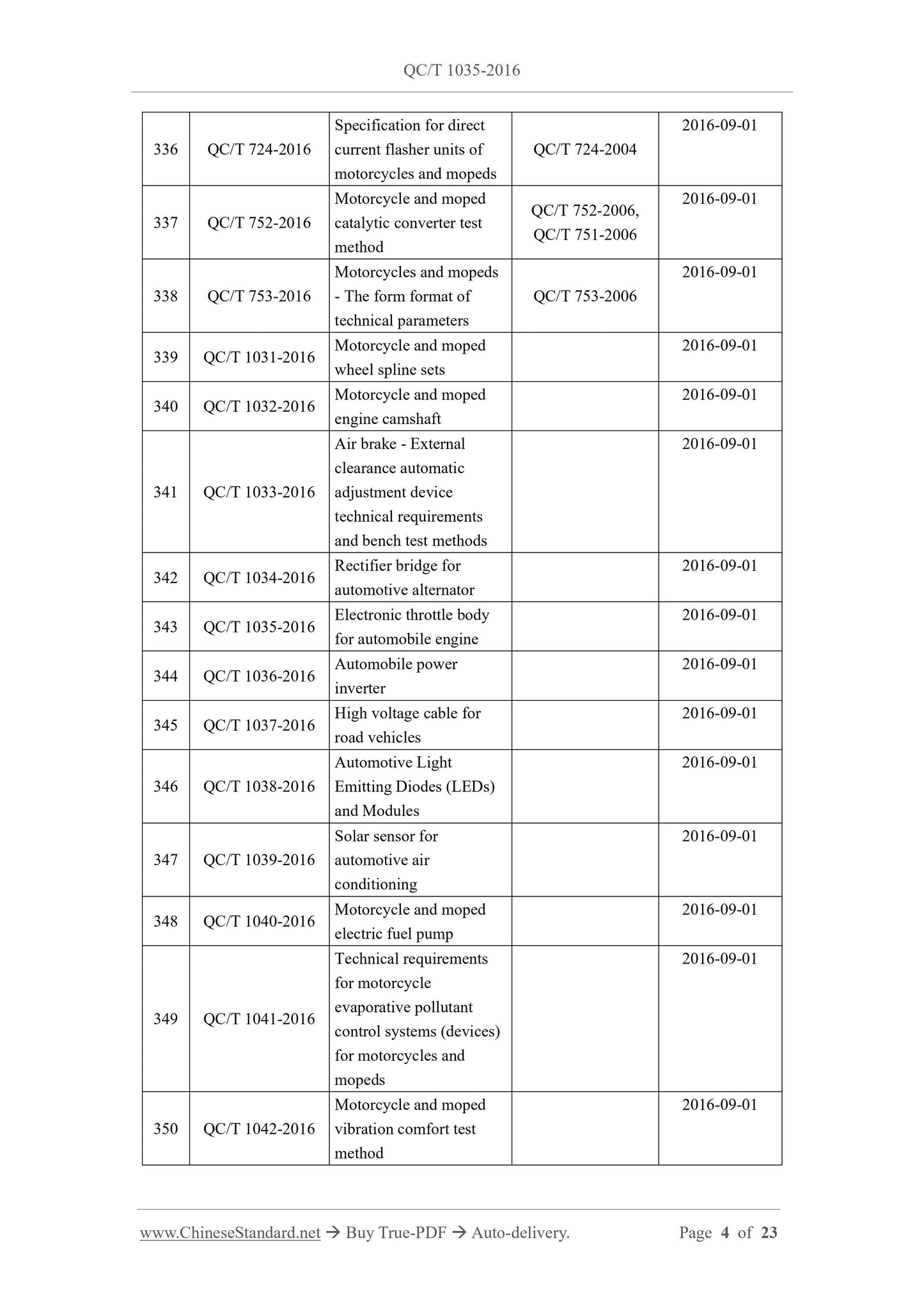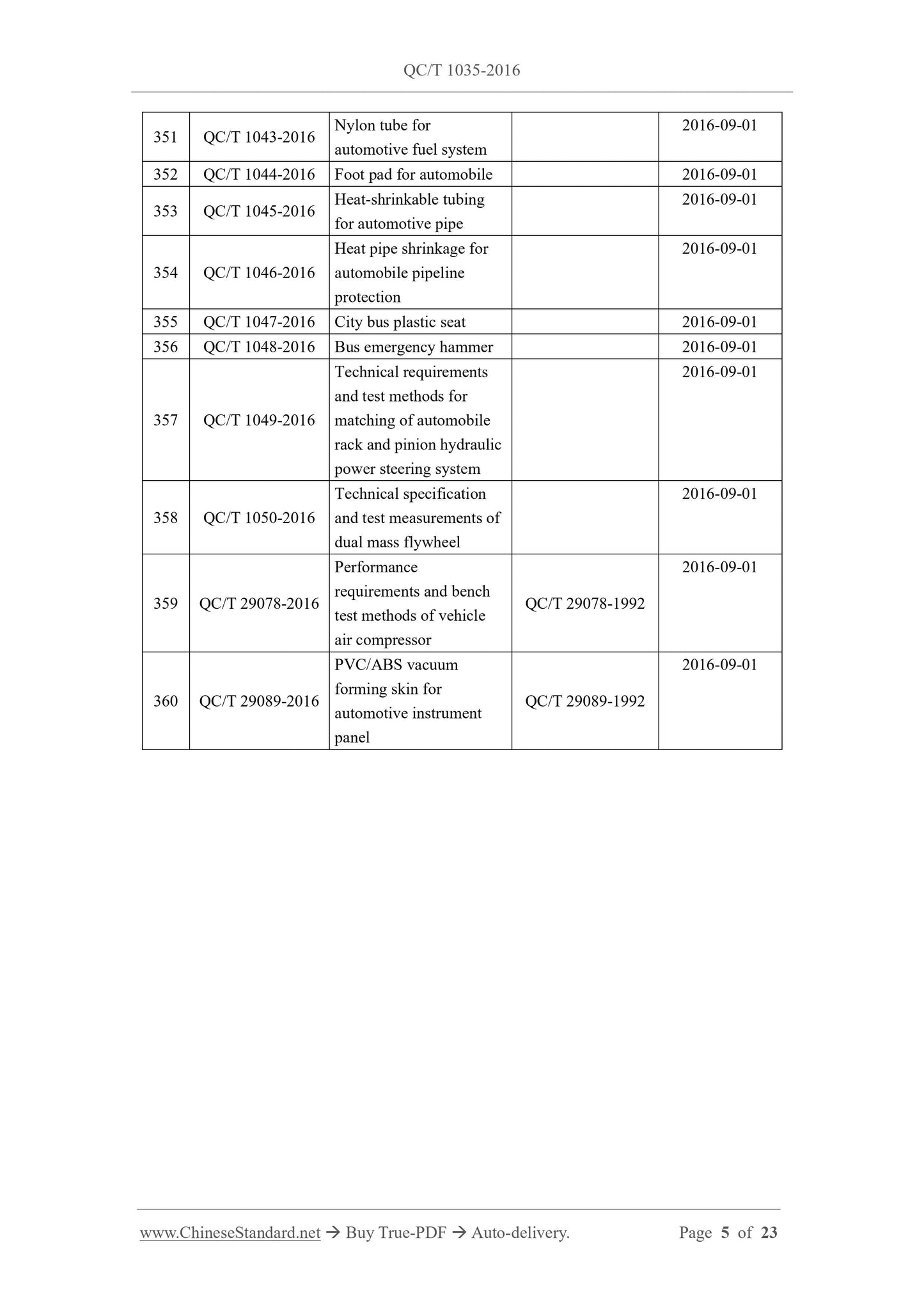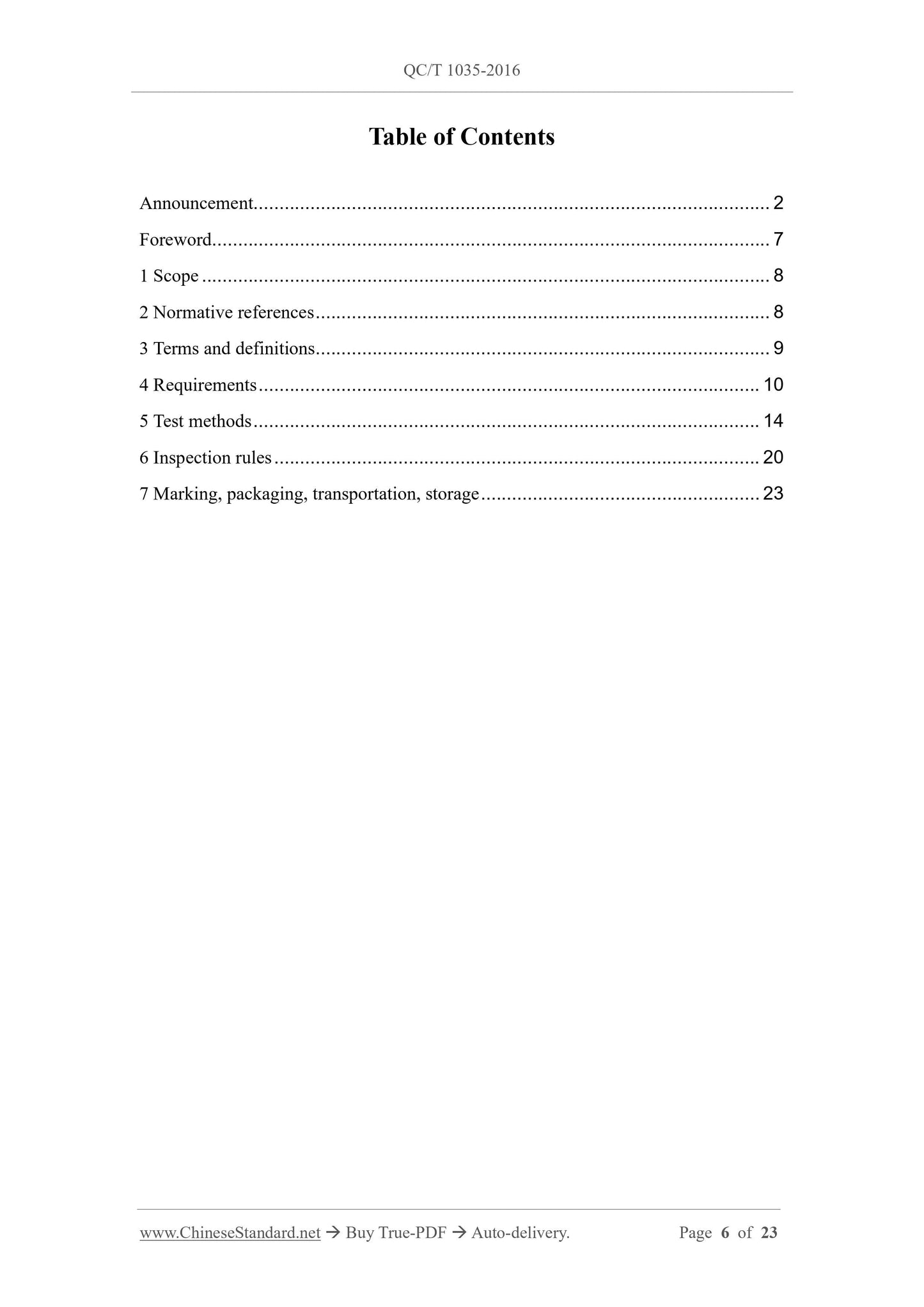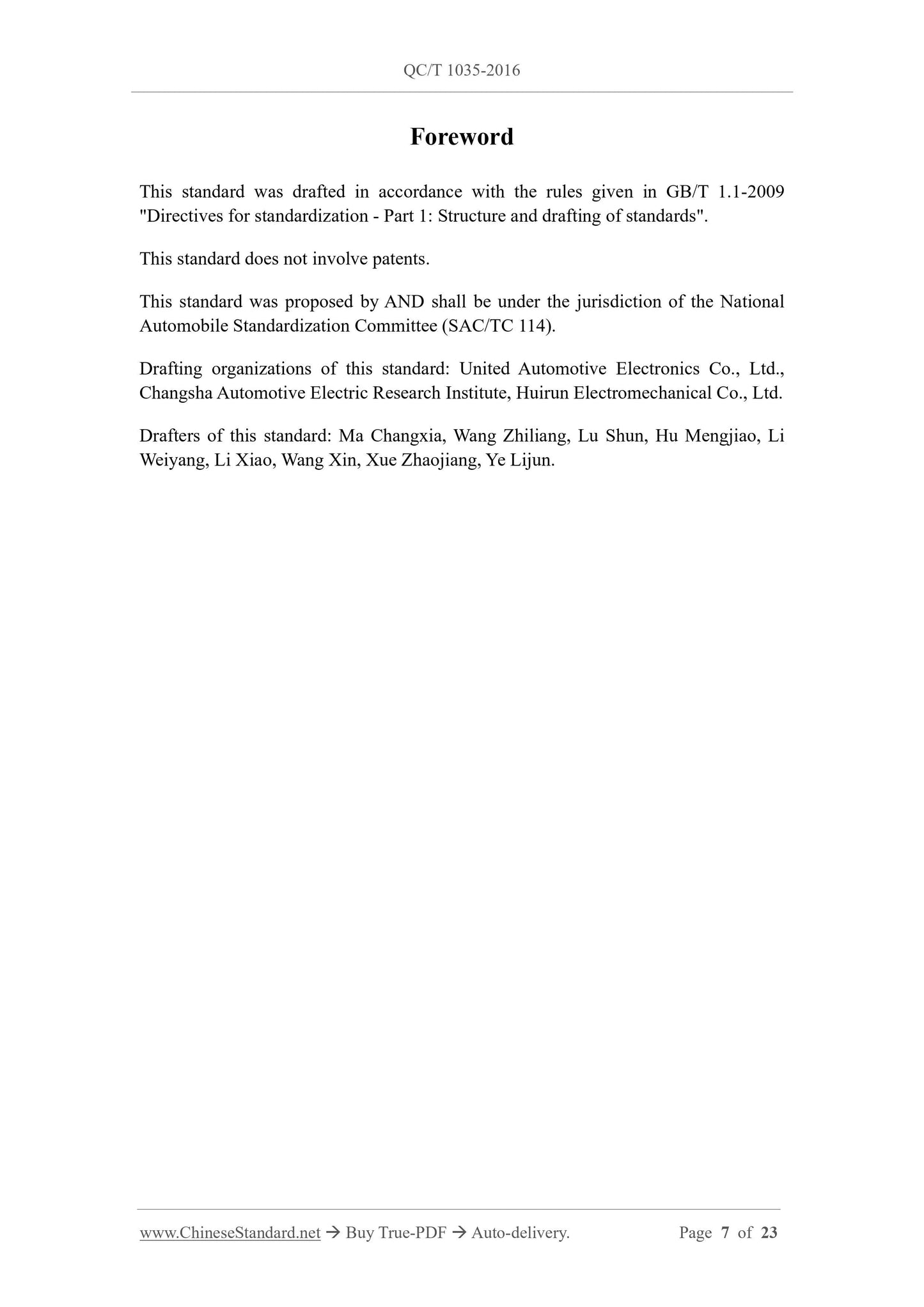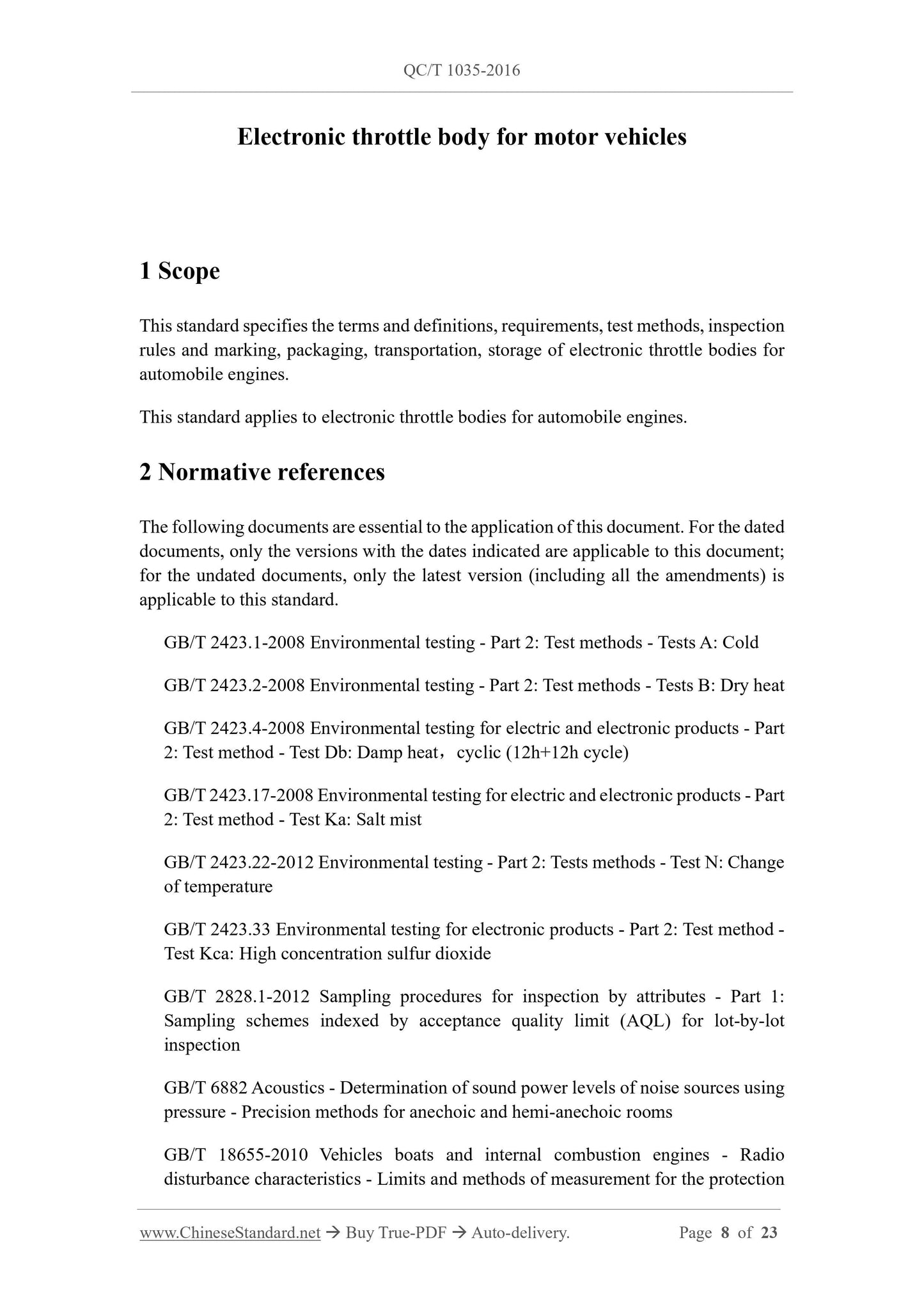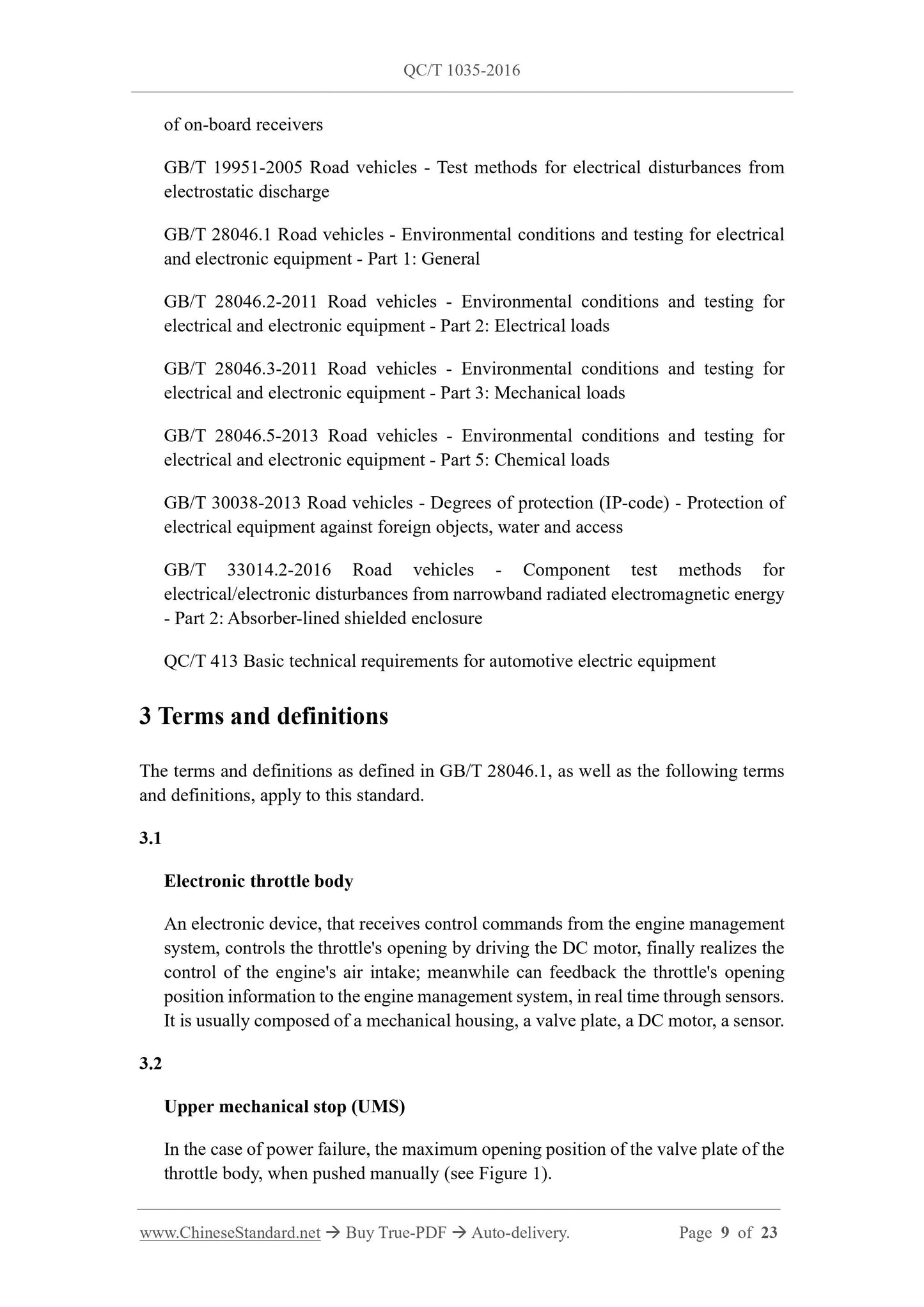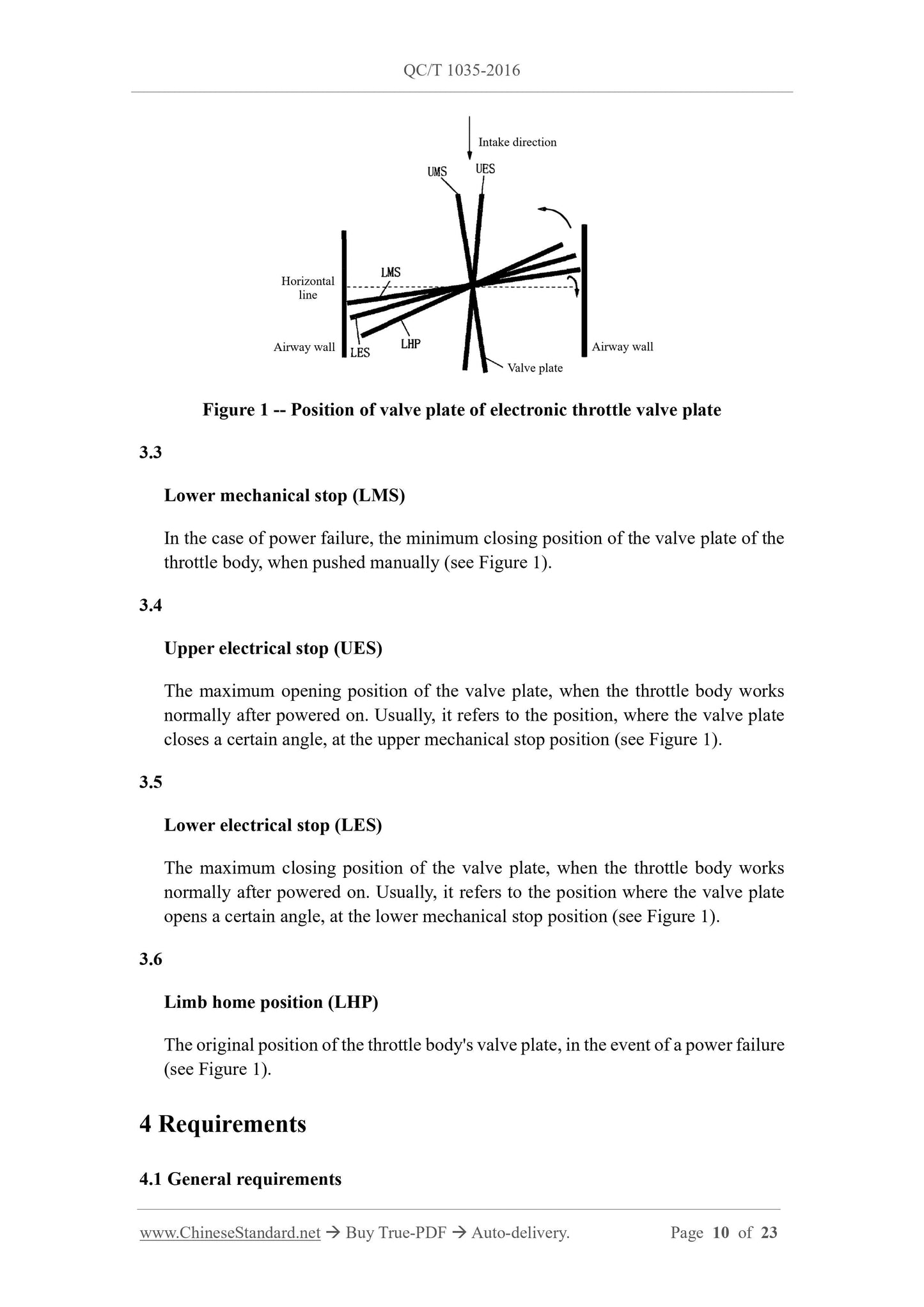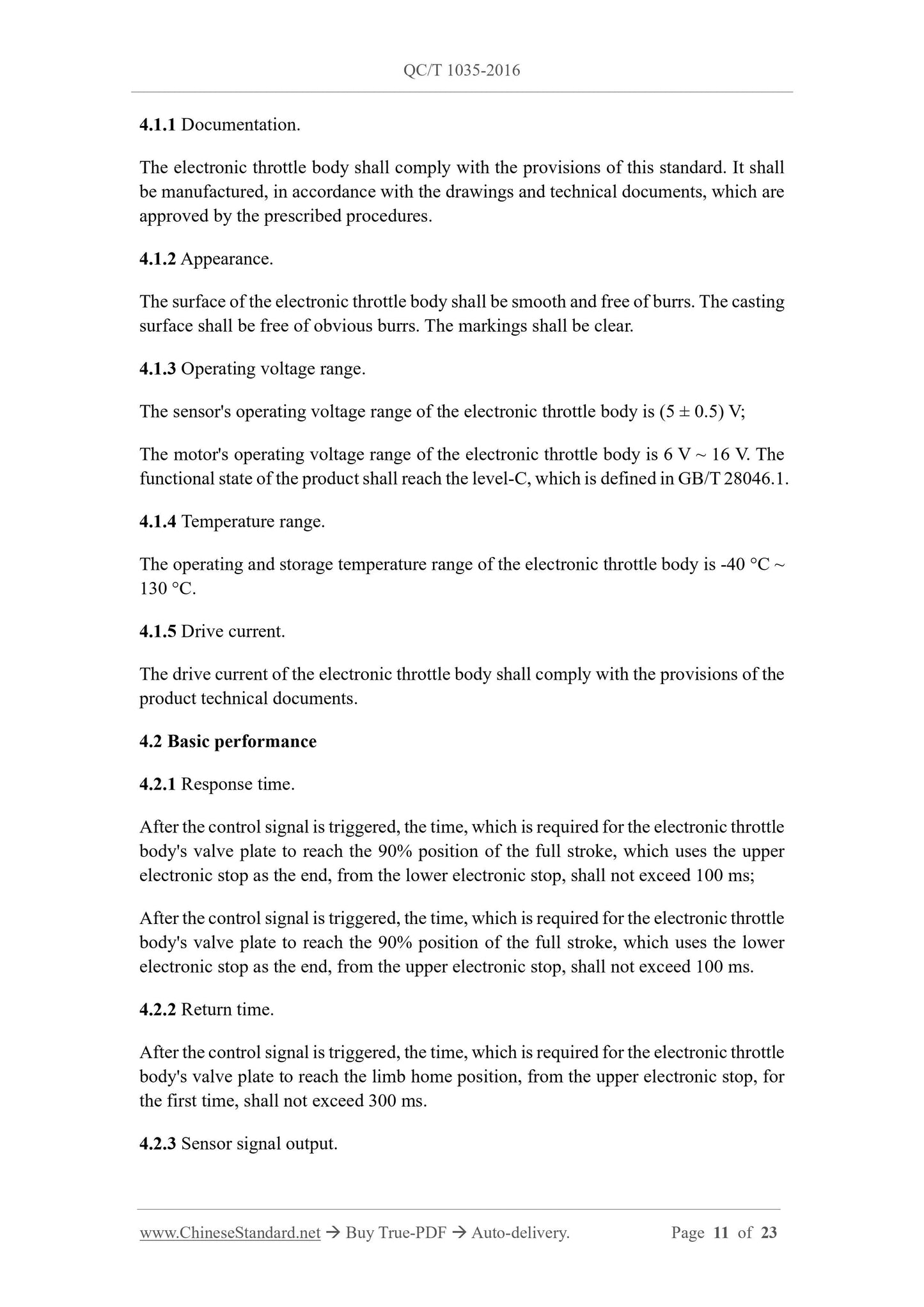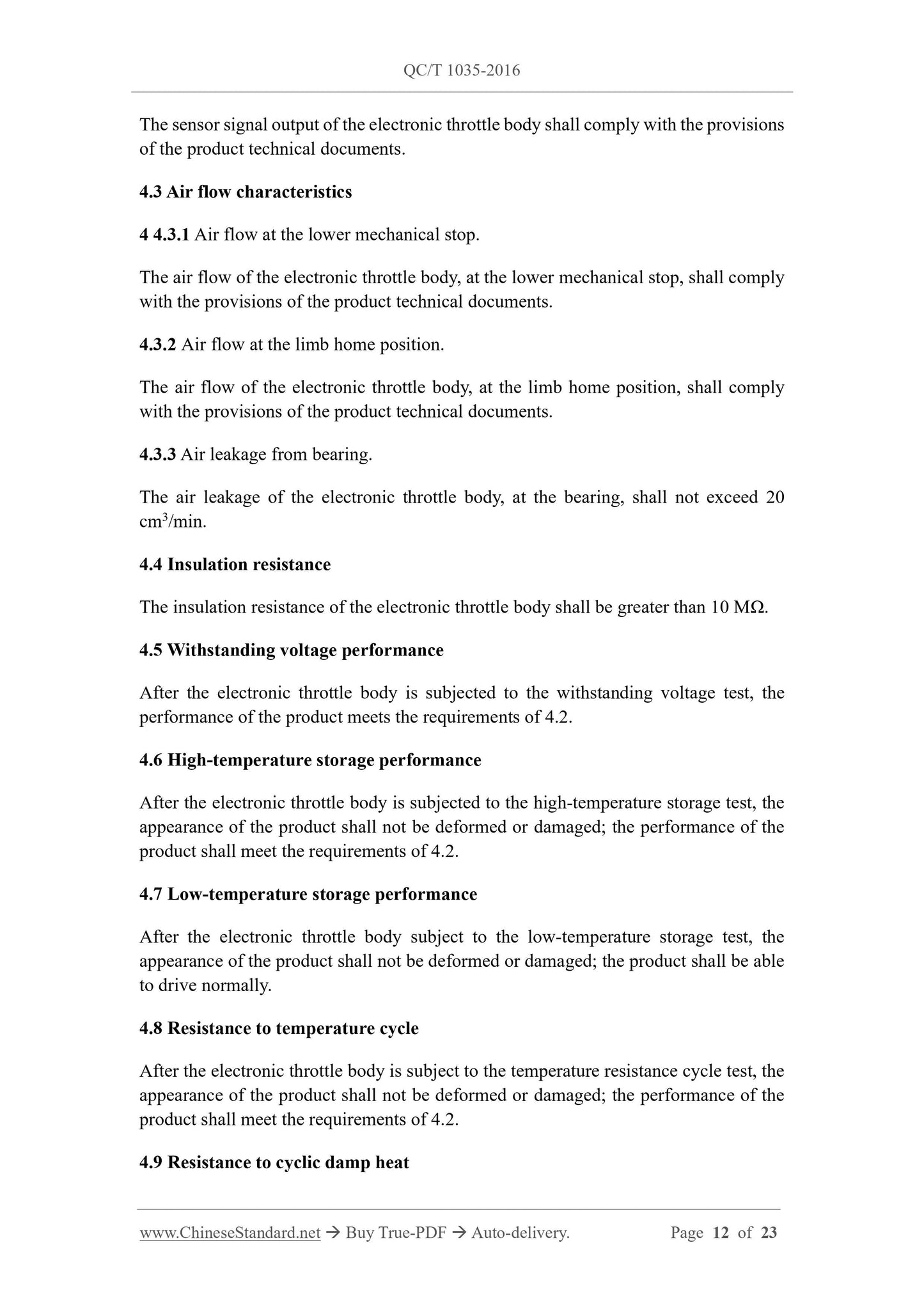1
/
of
12
PayPal, credit cards. Download editable-PDF & invoice in 1 second!
QC/T 1035-2016 English PDF (QCT1035-2016)
QC/T 1035-2016 English PDF (QCT1035-2016)
Regular price
$260.00 USD
Regular price
Sale price
$260.00 USD
Unit price
/
per
Shipping calculated at checkout.
Couldn't load pickup availability
Delivery: 3 seconds. Download true-PDF + Invoice.
Get QUOTATION in 1-minute: Click QC/T 1035-2016
Historical versions: QC/T 1035-2016
Preview True-PDF (Reload/Scroll if blank)
QC/T 1035-2016: Electronic throttle body for motor vehicles
QC/T 1035-2016
AUTOMOBILE INDUSTRY STANDARD
OF THE PEOPLE’S REPUBLIC OF CHINA
ICS 43.040.10
T 36
Electronic throttle body for motor vehicles
ISSUED ON: APRIL 05, 2016
IMPLEMENTED ON: SEPTEMBER 01, 2016
Issued by: Ministry of Industry and Information Technology of PRC
Table of Contents
Announcement... 2
Foreword ... 7
1 Scope ... 8
2 Normative references ... 8
3 Terms and definitions... 9
4 Requirements ... 10
5 Test methods ... 14
6 Inspection rules ... 20
7 Marking, packaging, transportation, storage ... 23
Electronic throttle body for motor vehicles
1 Scope
This standard specifies the terms and definitions, requirements, test methods, inspection
rules and marking, packaging, transportation, storage of electronic throttle bodies for
automobile engines.
This standard applies to electronic throttle bodies for automobile engines.
2 Normative references
The following documents are essential to the application of this document. For the dated
documents, only the versions with the dates indicated are applicable to this document;
for the undated documents, only the latest version (including all the amendments) is
applicable to this standard.
GB/T 2423.1-2008 Environmental testing - Part 2: Test methods - Tests A: Cold
GB/T 2423.2-2008 Environmental testing - Part 2: Test methods - Tests B: Dry heat
GB/T 2423.4-2008 Environmental testing for electric and electronic products - Part
2: Test method - Test Db: Damp heat, cyclic (12h+12h cycle)
GB/T 2423.17-2008 Environmental testing for electric and electronic products - Part
2: Test method - Test Ka: Salt mist
GB/T 2423.22-2012 Environmental testing - Part 2: Tests methods - Test N: Change
of temperature
GB/T 2423.33 Environmental testing for electronic products - Part 2: Test method -
Test Kca: High concentration sulfur dioxide
GB/T 2828.1-2012 Sampling procedures for inspection by attributes - Part 1:
Sampling schemes indexed by acceptance quality limit (AQL) for lot-by-lot
inspection
GB/T 6882 Acoustics - Determination of sound power levels of noise sources using
pressure - Precision methods for anechoic and hemi-anechoic rooms
GB/T 18655-2010 Vehicles boats and internal combustion engines - Radio
disturbance characteristics - Limits and methods of measurement for the protection
of on-board receivers
GB/T 19951-2005 Road vehicles - Test methods for electrical disturbances from
electrostatic discharge
GB/T 28046.1 Road vehicles - Environmental conditions and testing for electrical
and electronic equipment - Part 1: General
GB/T 28046.2-2011 Road vehicles - Environmental conditions and testing for
electrical and electronic equipment - Part 2: Electrical loads
GB/T 28046.3-2011 Road vehicles - Environmental conditions and testing for
electrical and electronic equipment - Part 3: Mechanical loads
GB/T 28046.5-2013 Road vehicles - Environmental conditions and testing for
electrical and electronic equipment - Part 5: Chemical loads
GB/T 30038-2013 Road vehicles - Degrees of protection (IP-code) - Protection of
electrical equipment against foreign objects, water and access
GB/T 33014.2-2016 Road vehicles - Component test methods for
electrical/electronic disturbances from narrowband radiated electromagnetic energy
- Part 2: Absorber-lined shielded enclosure
QC/T 413 Basic technical requirements for automotive electric equipment
3 Terms and definitions
The terms and definitions as defined in GB/T 28046.1, as well as the following terms
and definitions, apply to this standard.
3.1
Electronic throttle body
An electronic device, that receives control commands from the engine management
system, controls the throttle's opening by driving the DC motor, finally realizes the
control of the engine's air intake; meanwhile can feedback the throttle's opening
position information to the engine management system, in real time through sensors.
It is usually composed of a mechanical housing, a valve plate, a DC motor, a sensor.
3.2
Upper mechanical stop (UMS)
In the case of power failure, the maximum opening position of the valve plate of the
throttle body, when pushed manually (see Figure 1).
The sensor signal output of the electronic throttle body shall comply with the provisions
of the product technical documents.
4.3 Air flow characteristics
4 4.3.1 Air flow at the lower mechanical stop.
The air flow of the electronic throttle body, at the lower mechanical stop, shall comply
with the provisions of the product technical documents.
4.3.2 Air flow at the limb home position.
The air flow of the electronic throttle body, at the limb home position, shall comply
with the provisions of the product technical documents.
4.3.3 Air leakage from bearing.
The air leakage of the electronic throttle body, at the bearing, shall not exceed 20
cm3/min.
4.4 Insulation resistance
The insulation resistance of the electronic throttle body shall be greater than 10 MΩ.
4.5 Withstanding voltage performance
After the electronic throttle body is subjected to the withstanding voltage test, the
performance of the product meets the requirements of 4.2.
4.6 High-temperature storage performance
After the electronic throttle body is subjected to the high-temperature storage test, the
appearance of the product shall not be deformed or damaged; the performance of the
product shall meet the requirements of 4.2.
4.7 Low-temperature storage performance
After the electronic throttle body subject to the low-temperature storage test, the
appearance of the product shall not be deformed or damaged; the product shall be able
to drive normally.
4.8 Resistance to temperature cycle
After the electronic throttle body is subject to the temperature resistance cycle test, the
appearance of the product shall not be deformed or damaged; the performance of the
product shall meet the requirements of 4.2.
4.9 Resistance to cyclic damp heat
After the electronic throttle body is subjected to the wet heat cycle test, the appearance
of the product shall not be deformed or damaged; the performance of the product shall
meet the requirements of 4.2.
4.10 Salt spray resistance
After the electronic throttle body is subjected to the salt spray resistance test, the
appearance of the product shall not have abnormal corrosive damage; the performance
of the product shall meet the requirements of 4.2.
4.11 Resistance to high-concentration of sulfur dioxide
After the electronic throttle body is subjected to the high-concentration sulfur dioxide
resistance test, the appearance of the product shall not have abnormal corrosive damage;
the performance of the product shall meet the requirements of 4.2.
4.12 Chemical resistance
After the electronic throttle body is subjected to the test of resistance to chemical
reagents, the performance of the product shall meet the requirements of 4.2.
4.13 Anti-free fall performance
After the electronic throttle body is subjected to the drop test, the product shall not have
hidden damage.
4.14 Vibration resistance
After the electronic throttle body is subjected to the sinusoidal vibration test, the
appearance of the product is not deformed or damaged; the performance of the product
shall meet the requirements of 4.2.
4.15 Durability
After the electronic throttle body is subjected to the durability test, the appearance of
the product is not deformed or damaged; the performance of the product shall meet the
requ...
Get QUOTATION in 1-minute: Click QC/T 1035-2016
Historical versions: QC/T 1035-2016
Preview True-PDF (Reload/Scroll if blank)
QC/T 1035-2016: Electronic throttle body for motor vehicles
QC/T 1035-2016
AUTOMOBILE INDUSTRY STANDARD
OF THE PEOPLE’S REPUBLIC OF CHINA
ICS 43.040.10
T 36
Electronic throttle body for motor vehicles
ISSUED ON: APRIL 05, 2016
IMPLEMENTED ON: SEPTEMBER 01, 2016
Issued by: Ministry of Industry and Information Technology of PRC
Table of Contents
Announcement... 2
Foreword ... 7
1 Scope ... 8
2 Normative references ... 8
3 Terms and definitions... 9
4 Requirements ... 10
5 Test methods ... 14
6 Inspection rules ... 20
7 Marking, packaging, transportation, storage ... 23
Electronic throttle body for motor vehicles
1 Scope
This standard specifies the terms and definitions, requirements, test methods, inspection
rules and marking, packaging, transportation, storage of electronic throttle bodies for
automobile engines.
This standard applies to electronic throttle bodies for automobile engines.
2 Normative references
The following documents are essential to the application of this document. For the dated
documents, only the versions with the dates indicated are applicable to this document;
for the undated documents, only the latest version (including all the amendments) is
applicable to this standard.
GB/T 2423.1-2008 Environmental testing - Part 2: Test methods - Tests A: Cold
GB/T 2423.2-2008 Environmental testing - Part 2: Test methods - Tests B: Dry heat
GB/T 2423.4-2008 Environmental testing for electric and electronic products - Part
2: Test method - Test Db: Damp heat, cyclic (12h+12h cycle)
GB/T 2423.17-2008 Environmental testing for electric and electronic products - Part
2: Test method - Test Ka: Salt mist
GB/T 2423.22-2012 Environmental testing - Part 2: Tests methods - Test N: Change
of temperature
GB/T 2423.33 Environmental testing for electronic products - Part 2: Test method -
Test Kca: High concentration sulfur dioxide
GB/T 2828.1-2012 Sampling procedures for inspection by attributes - Part 1:
Sampling schemes indexed by acceptance quality limit (AQL) for lot-by-lot
inspection
GB/T 6882 Acoustics - Determination of sound power levels of noise sources using
pressure - Precision methods for anechoic and hemi-anechoic rooms
GB/T 18655-2010 Vehicles boats and internal combustion engines - Radio
disturbance characteristics - Limits and methods of measurement for the protection
of on-board receivers
GB/T 19951-2005 Road vehicles - Test methods for electrical disturbances from
electrostatic discharge
GB/T 28046.1 Road vehicles - Environmental conditions and testing for electrical
and electronic equipment - Part 1: General
GB/T 28046.2-2011 Road vehicles - Environmental conditions and testing for
electrical and electronic equipment - Part 2: Electrical loads
GB/T 28046.3-2011 Road vehicles - Environmental conditions and testing for
electrical and electronic equipment - Part 3: Mechanical loads
GB/T 28046.5-2013 Road vehicles - Environmental conditions and testing for
electrical and electronic equipment - Part 5: Chemical loads
GB/T 30038-2013 Road vehicles - Degrees of protection (IP-code) - Protection of
electrical equipment against foreign objects, water and access
GB/T 33014.2-2016 Road vehicles - Component test methods for
electrical/electronic disturbances from narrowband radiated electromagnetic energy
- Part 2: Absorber-lined shielded enclosure
QC/T 413 Basic technical requirements for automotive electric equipment
3 Terms and definitions
The terms and definitions as defined in GB/T 28046.1, as well as the following terms
and definitions, apply to this standard.
3.1
Electronic throttle body
An electronic device, that receives control commands from the engine management
system, controls the throttle's opening by driving the DC motor, finally realizes the
control of the engine's air intake; meanwhile can feedback the throttle's opening
position information to the engine management system, in real time through sensors.
It is usually composed of a mechanical housing, a valve plate, a DC motor, a sensor.
3.2
Upper mechanical stop (UMS)
In the case of power failure, the maximum opening position of the valve plate of the
throttle body, when pushed manually (see Figure 1).
The sensor signal output of the electronic throttle body shall comply with the provisions
of the product technical documents.
4.3 Air flow characteristics
4 4.3.1 Air flow at the lower mechanical stop.
The air flow of the electronic throttle body, at the lower mechanical stop, shall comply
with the provisions of the product technical documents.
4.3.2 Air flow at the limb home position.
The air flow of the electronic throttle body, at the limb home position, shall comply
with the provisions of the product technical documents.
4.3.3 Air leakage from bearing.
The air leakage of the electronic throttle body, at the bearing, shall not exceed 20
cm3/min.
4.4 Insulation resistance
The insulation resistance of the electronic throttle body shall be greater than 10 MΩ.
4.5 Withstanding voltage performance
After the electronic throttle body is subjected to the withstanding voltage test, the
performance of the product meets the requirements of 4.2.
4.6 High-temperature storage performance
After the electronic throttle body is subjected to the high-temperature storage test, the
appearance of the product shall not be deformed or damaged; the performance of the
product shall meet the requirements of 4.2.
4.7 Low-temperature storage performance
After the electronic throttle body subject to the low-temperature storage test, the
appearance of the product shall not be deformed or damaged; the product shall be able
to drive normally.
4.8 Resistance to temperature cycle
After the electronic throttle body is subject to the temperature resistance cycle test, the
appearance of the product shall not be deformed or damaged; the performance of the
product shall meet the requirements of 4.2.
4.9 Resistance to cyclic damp heat
After the electronic throttle body is subjected to the wet heat cycle test, the appearance
of the product shall not be deformed or damaged; the performance of the product shall
meet the requirements of 4.2.
4.10 Salt spray resistance
After the electronic throttle body is subjected to the salt spray resistance test, the
appearance of the product shall not have abnormal corrosive damage; the performance
of the product shall meet the requirements of 4.2.
4.11 Resistance to high-concentration of sulfur dioxide
After the electronic throttle body is subjected to the high-concentration sulfur dioxide
resistance test, the appearance of the product shall not have abnormal corrosive damage;
the performance of the product shall meet the requirements of 4.2.
4.12 Chemical resistance
After the electronic throttle body is subjected to the test of resistance to chemical
reagents, the performance of the product shall meet the requirements of 4.2.
4.13 Anti-free fall performance
After the electronic throttle body is subjected to the drop test, the product shall not have
hidden damage.
4.14 Vibration resistance
After the electronic throttle body is subjected to the sinusoidal vibration test, the
appearance of the product is not deformed or damaged; the performance of the product
shall meet the requirements of 4.2.
4.15 Durability
After the electronic throttle body is subjected to the durability test, the appearance of
the product is not deformed or damaged; the performance of the product shall meet the
requ...
Share
